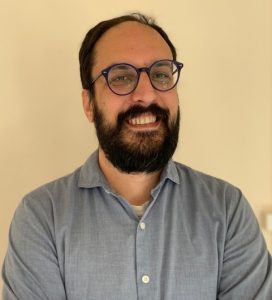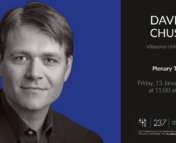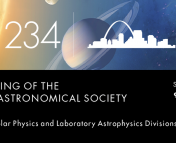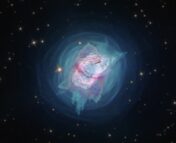In this series of posts, we sit down with a few of the keynote speakers of the 238th AAS meeting to learn more about them and their research. You can see a full schedule of their talks here, and read our other interviews here!

Dr. Enrique López Rodríguez. Image courtesy of Dr. López Rodríguez.
A Starry Start
Now a research scientist at the Kavli Institute for Particle Astrophysics and Cosmology at Stanford University, Dr. Enrique López Rodríguez was once a kid from the Canary Islands in love with the night sky. “I’ve always liked astronomy,” Dr. López Rodríguez explained. “
“We have very good skies and the Astrophysics Institute of the Canary Islands is in my hometown, not even a mile from my house…so I think the passion just came from there. These days, Dr. López Rodríguez spends a lot of his time thinking about magnetic fields and how they impact galaxy evolution and star formation—though this interest has a separate origin story. “The interest in magnetic fields, it comes from one of my classes in college, Optics 2,” he recounted, explaining that he did not pass the class, leading his professor to deem him “not mature enough to understand polarimetry.” Polarimetry entails measuring the polarization of light coming from different sources, which tells us about the magnetic fields present in the system emitting the light (for a more detailed introduction to polarimetry, check out this bite!). After that, López Rodríguez spent the entire summer studying polarimetry in-depth and became fascinated by its potential; he now actively seeks different fields in astronomy where he can use polarimetry to make research gains. These include galaxy formation and gas flows which, López Rodríguez explains, are all related at the end of the day.
A Galaxy and Its Magnetic Fields
When it comes to galaxies, Dr. López Rodríguez is interested in how all the forces of nature combine for galaxies to evolve. “When you look at how galaxies form it is an interplay between dark matter, gravity, turbulence, feedback, and always at the end, the magnetic fields. The question is, how do all these forces interconnect to each other in order to form the galaxy that we know today?” Dr. López Rodríguez specifically approaches this question from a magnetohydrodynamical framework—but what does that mean, exactly?
“Galaxies have ionized gas, and this ionized gas is moving and rotating around,” he explained. Because of Maxwell’s equations, the charged particles moving around with the ionized gas necessarily create magnetic fields. “It’s very easy to generate a magnetic field, but they are complicated to destroy. The universe has magnetic fields everywhere. Sometimes the magnetic field is not strong enough so it follows the flow of gas around the galaxy. Here you have one ingredient that is very important and always present, independently of the astrophysical source you are looking at. Magnetic fields are a key ingredient for the formation of stars and galaxies. I’m focused on quantifying the strength and geometry of the magnetic field and its importance in galaxy evolution.”
Mapping the Magnetism
How do you measure magnetic fields? Dr. López Rodríguez explained that there are two main wavelengths regimes which are useful: the radio and the far-infrared. Radio data is good for studying magnetic fields in the diffuse interstellar medium, between star-forming regions, and has been used for a long time. On the other hand, capturing far-infrared emission from the Earth is tricky because all the water vapor in our atmosphere also emits in the far-infrared. “We are studying the magnetic fields at the peak of thermal emission in galaxies, where the molecular clouds and star formation’s emission peaks. This usually happens in the far-infrared wavelengths at around 100 microns.”
This is where SOFIA, the Stratospheric Observatory for Infrared Astronomy, comes in: SOFIA is a Boeing 747SP NASA aircraft flying above all that pesky infrared (and most of the UV!) blocking atmosphere and taking measurements. “SOFIA has a new instrument called HAWC+, the High-resolution Airborne Wideband Camera Plus. What makes this instrument special is that it has a polarimeter instrument inside, so that gives us the opportunity to study the electromagnetic components.” Dr. López Rodríguez will be presenting some results from SOFIA in his Fred Kavli Plenary Lecture: “We have a series of very well-studied galaxies in different regions. For example, we have Centaurus-A, that is a merging galaxy, and we discovered that the magnetic field that we see is being modified due to the merging of the two galaxies. And I will show that the intergalactic medium is also magnetized due to the outflows of starburst galaxies. So I will present how the different types of galaxies and evolution of galaxies will modify the magnetic fields in the universe.”
Instrument-Driven Science
Looking back on his career thus far, Dr. López Rodríguez found that his science has always been driven by his instruments. “I find it interesting, the link between instrumentation and science exploration. I’ve always been fascinated with working with a new polarimeter, commissioning it, finding all the tricky parts, and optimizing it. My career path has always been related with new instrumentation and wavelength regimes, and what we can discover from there, which has driven my career since.”
To hear more about funky magnetic fields, cool instruments, and different types of galaxies, tune into Dr. López Rodríguez’s Fred Kavli Plenary Lecture at 11 AM ET on Monday, June 7 at #AAS238!
Astrobite edited by Huei Sears
Featured image credit: AAS




